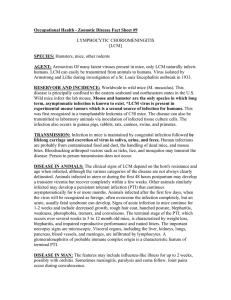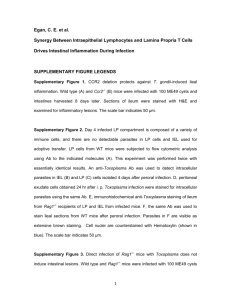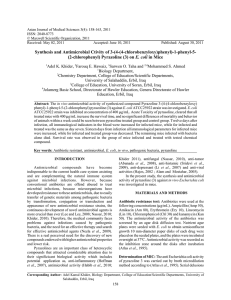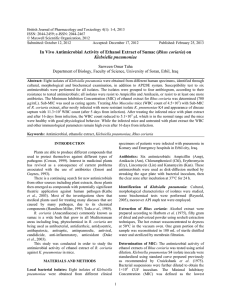Table 1: Clinical status of mice 48 hours after induction of
advertisement
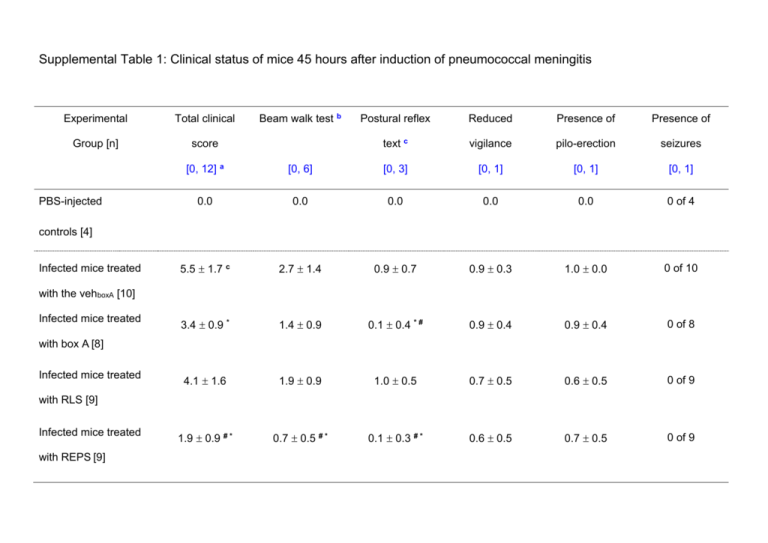
Supplemental Table 1: Clinical status of mice 45 hours after induction of pneumococcal meningitis Experimental Total clinical Group [n] score PBS-injected Beam walk test b Postural reflex Reduced Presence of Presence of text c vigilance pilo-erection seizures [0, 12] a [0, 6] [0, 3] [0, 1] [0, 1] [0, 1] 0.0 0.0 0.0 0.0 0.0 0 of 4 5.5 1.7 c 2.7 1.4 0.9 0.7 0.9 0.3 1.0 0.0 0 of 10 3.4 0.9 * 1.4 0.9 0.1 0.4 * # 0.9 0.4 0.9 0.4 0 of 8 4.1 1.6 1.9 0.9 1.0 0.5 0.7 0.5 0.6 0.5 0 of 9 1.9 0.9 # * 0.7 0.5 # * 0.1 0.3 # * 0.6 0.5 0.7 0.5 0 of 9 controls [4] Infected mice treated with the vehboxA [10] Infected mice treated with box A [8] Infected mice treated with RLS [9] Infected mice treated with REPS [9] NOTES: a In healthy animals, the score is 0 points. The maximum total score value is 12. Mice with 11 or more score points were considered terminally ill and euthanized due to ethics. None of the investigated mice showed scores above 10 within the observation period. The values in brackets show minimum and maximum values. b The goal of the beam walk test for a mouse is walking on wooden beams with decreasing diameters (13 mm, 9 mm, or 5 mm in diameter). The score is 0 or 1, if a mouse was able to traverse or stay on a beam of 5 mm in diameter. A score value of 2 or 3 is attributed to a mouse able to walk or stay on the 9 mm-beam. Failure of walking or staying along the thickest beam, the score assigned is 5 or 6, respectively. c For postural reflex test, mice are lifted upon fixation of the tail and symmetry in the movement of the four limbs is examined. Score 0 indicates that all four limbs extended symmetrically, 1 = limbs on one side extended to a lesser degree or more slowly than those on the other side, 2 = minimal movement of limbs of one or both sides, and 3 = lack of movement of limbs of one or both sides. The other measures are observational in nature, indicating the presence or absence of the respective clinical symptom. Above all, the scoring system was designed to capture neurological (motor) disabilities, explaining the high number of points obtainable in the two motor tests (beam walk and postural reflex test). The other parameters like the presence of seizure are added in order to provide a broader picture of the clinical status of the mice. * p < 0.05, compared to infected mice treated with the vehboxA, and # p < 0.05, compared to infected mice treated with RLS, using Kruskal Wallis ANOVA and Mann Whitney U test plus alpha corrections for post hoc analysis. deviations. c Data are means standard





